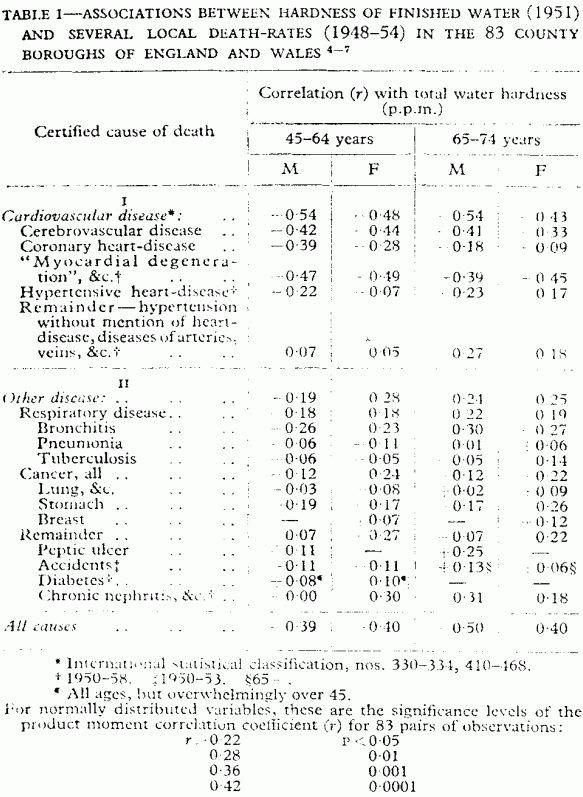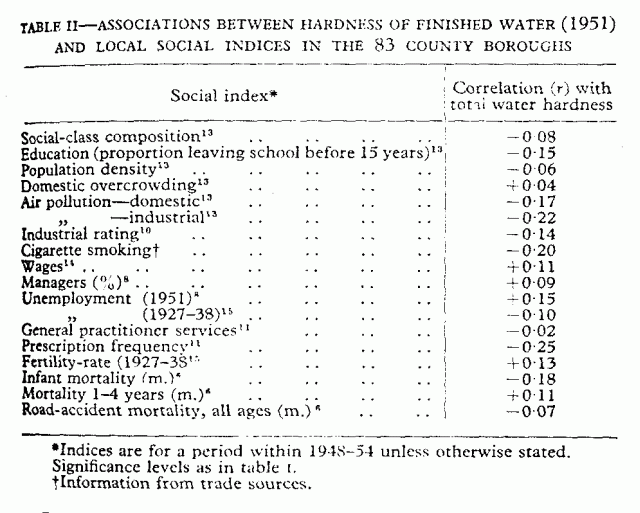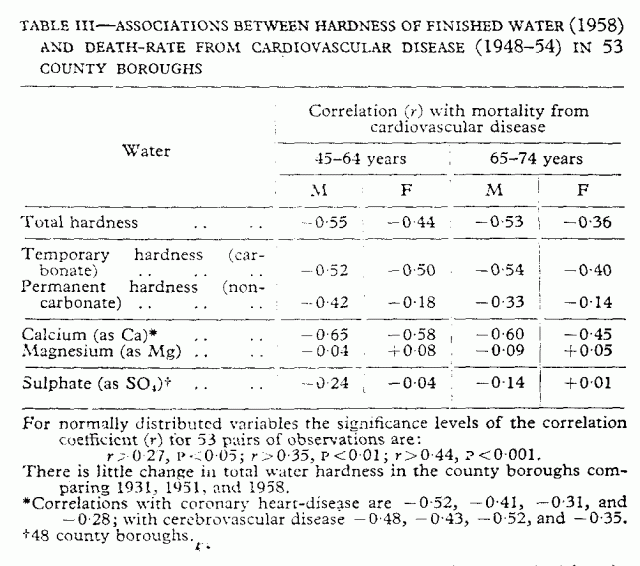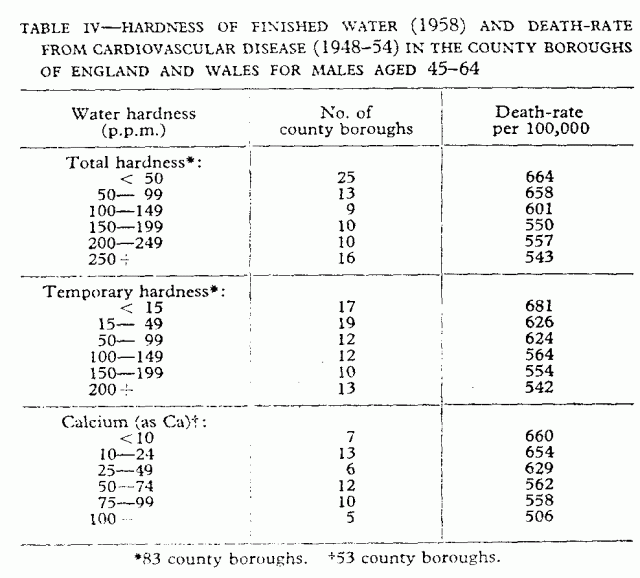The Lancet, April 22, 1961
Preliminary Communication
HARDNESS OF LOCAL WATER-SUPPLIES AND MORTALITY FROM
CARDIOVASCULAR DISEASE
in the County Boroughs of England and Wales
Schroeder,1 2 following Japanese work,3
found substantial and highly significant correlations between
average hardness of the finished (drinking) water and mortality
from cardiovascular disease in the states and large
municipalities of the United States. These associations were
negative—i.e., the softer the water the higher the
cardiovascular death-rate. A reconnaissance using available
official statistics has therefore been made in the county
boroughs of England and Wales to see whether there is a case for
investigation in this country. A third of the population lives in
these towns, and differences in cardiovascular mortality among
them are well recognised. Around the 1951 census, for example, in
men aged 45-64 there was a range of 168-382 per 100,000 in
coronary heart-disease and of 82-182 in cerebrovascular
disease.4
DEATH-RATES AND HARDNESS OF WATER
Correlations were calculated between (a) death-rates
from thirty-eight causes and groups of causes of death in 170
sex-age brackets (i.e., in every instance where data were
available and numbers at all adequate), and (b) indices of
average hardness of the local water as finished and
delivered into supply in the 83 county boroughs. The correlation
coefficient is a useful method of exploring a question such as
this. The distributions being examined, however, are sometimes
very skewed, and problems therefore arise which we are trying to
solve in various ways.
Table I gives the results for the leading causes of death, and
some others of special interest, in middle age and at 65-74.
Attention may be drawn to several features. There are striking
correlations (part I, line 1), all negative, between water
hardness and total cardiovascular mortality: the softer on
average the local water in the county boroughs of England and
Wales, the higher on average the cardiovascular death-rate. Among
the groupings within cardiovascular disease (there is no choice
about these) the correlations are substantial and highly
significant for deaths from vascular lesions of the nervous
system and for those certified to "myocardial degeneration",
&c. In coronary heart-disease the correlation is sizeable
only in middle-aged men. Correlations with mortality certified to
hypertension and other cardiovascular causes are remarkable.

Correlations with non-cardiovascular causes of death (part II
of table I) are small and mostly insignificant at the 1% level.
The main exception is bronchitis, and this is interesting in view
of the several connections between bronchitis and heart-disease.
The correlations for noncardiovascular mortality ("other
disease") when bronchitis is excluded fall to -0.12, -0.26,
-0.13, and -0.20.
Correlations in diabetes are negligible, and with chronic
nephritis, &c., irregular. (There are too few deaths to
attempt any study of stone.)* There are no other results of
interest.
LOCAL WATER-SUPPLIES AND OTHER LOCAL FACTORS
The main problem in this kind of "ecological" study is to
determine whether the correlations found between water hardness
and cardiovascular disease are likely to represent cause and
effect, or whether they merely reflect other factors with which
both the water and the mortality are associated. Thus, so far as
the county boroughs are concerned, soft water is found mainly in
Lancashire,the West Riding of Yorkshire, and South Wales. There
may be host factors in the population which arc responsible for
the high mortality from cardiovascular disease in the regions,
and water softness could be fortuitous: alternatively other
environmental factors in these regions may be responsible. For
example, the softness of local water was one of the reasons why
the industrial revolution (cotton, wool) started in south-east
Lancashire and the West Riding: it may he that industrial and
urban conditions increase the cardiovascular death-rate, again
regardless of the composition of local water.
Much more work will have to he done on these questions.
Meanwhile, it is worth noting that although mortality in general
is high in the three main soft-water areas, it is only in
cardiovascular disease that important correlations between
mortality and the water-supply appear — i.e., there seems
to be a specific relationship between water and cardiovascular
mortality. Furthermore, when the county boroughs of Lancashire,
the West Riding and South Wales are excluded from the
calculations, substantial and highly significant correlations
between water hardness and cardiovascular death-rates are still
found among the remaining 51 towns—a good test in itself of
the hypothesis.
Comparison within regions is helpful in this kind of
problem. When this is done, the results in general agree with the
national figures. However, Birmingham, with very soft water, has
low mortality similar to the neighbouring Midland county boroughs
with their hard water. This observation may well be crucial,
though difficult to interpret in view of the traffic and exchange
there is among people, food, and drink across local boundaries
within a region.
In brief, questions must be asked whether the association with
water is a matter of regional variation. Equally, it must be
asked, might regional differences in cardiovascular mortality be
due in some measure to differences in their water-supply?
Intensive study of this will mean extending the analysis beyond
the county boroughs—a daunting prospect. The same problems
are arising in the United States.12 It seems unlikely
that the same regional factors associated with cardiovascular
mortality could be producing indirect correlations with
water-supply both in the United States and in England and Wales,
and as remarkable if different regional factors happened to do
so. In England mortality in general, cardiovascular and other, is
higher in the North, but this latitude factor has been found to
be irrelevant to the main problem. Correlations between water
hardness and local rainfall, temperature, and sunshine averages
in the county boroughs will shortly be available.
SOCIAL ENVIRONMENT
Some progress has been made with the problem of possible
confounding social factors. Correlations were calculated between
water hardness in the county boroughs and a wide variety of local
environmental indices (table II). Only two of these correlated
significantly at the 5% level with water hardness, and none did
so at 1%. The associations with air pollution may be relevant;
but, when correlations were recalculated to eliminate the effects
of air pollution, those between cardiovascular mortality and
water hardness were scarcely affected, while the highish
correlations already mentioned between bronchitis and water
hardness dropped sharply.

So far, then, there is no indication that local water hardness
is merely indicating some important social-environmental cause of
death from cardiovascular disease. Some interesting associations
were, of course, found between some of these social indices and
local death-rates, and these will be described elsewhere.
CONSTITUENTS OF THE WATER
Work is proceeding on this. Table III gives the results for
the 53 county boroughs with the fullest data. These are mainly
larger towns, and they seem to be representative (line 1 of table
III corresponds to line 1 of table I). Table III probably gives
the best information on local water in the present communication.
Correlations with cardiovascular mortality are high for calcium
content, contrasting remarkably with magnesium. These are the
main cations present in British drinking water; no figures for
others (e.g., sodium) are available.†

RANGE OF MORTALITY
Table IV illustrates the kind of variation of mortality with
water hardness that has been found.

FURTHER WORK
Clearly there is a case for further inquiry, and several lines
have already been suggested. It will be possible to extend the
mortality analysis to social class, if not to occupation.
Historical study of local death-rates from cardiovascular disease
is proving very laborious. There is no suggestion that increase
in water softening in recent years may be importantly involved in
the recent increase of coronary heart-disease (in any event the
coronary correlations are less impressive than those with
cerebrovascular disease, and there is no suggestion of any rise
in the incidence of the latter). Postmortem material may give a
clue to which of the main elements of cardiovascular disease in
middle age-mural atheroma, intravascular thrombosis,
hypertension16 is specially involved. It must be
emphasised that all data presented refer to mortality, and some
attempt will have to be made to study incidence and morbidity.
Ad-hoc examination of samples of drinking water will
need to be undertaken. Several modes of action of water vis-a-vis
cardiovascular disease suggest themselves: hard water may be
protective because of its mineral content (cf., fluorine and
dental caries) or, conceivably, soft water could carry harmful
trace elements into supply. Both of these, and other
possibilities, will have to be investigated.
CONCLUSION
The softer the water-supply in the county boroughs of England
and Wales the higher the local death-rate from cardiovascular
disease tends to be. What this means is not at present clear, and
further investigation is indicated.
We are greatly obliged to the water authorities of the County
boroughs and their chief officers, and to Dr. E. Windle Taylor of
the Metropolitan Water Board, for their generous Cooperation, We
are also most grateful for access to I.B.M. computers, including
, services by the I.B.M. Applied Science Division and its
representatives. The General Register Office, the Ministries of
Health and of Housing and Local Government, Prof. C. J. O. R.
Morris, and Prof. F. L. Warren of the London Hospital Medical
College, and the computing and clerical staff of the unit have
given us much help.
J. N. Morris
M.A. Glasg., F.R.C.P., D.P.H.
M. D. Crawford
M.D. Glasg.
J. A. Heady
M.A. Oxon
Social Medicine Research Unit of the Medical Research Council
and Department of Social Medicine, London Hospital Medical
College, London, E.2
*Causes of death and groups of causes have been analysed as
presented in the tables of the Registrar General. Those of deaths
certified to diabetes and hypertension are difficult to
interpret. In the case of bronchitis it is worth remembering that
there is considerable interchange of this diagnosis with
"myocardial degeneration" on death certificates. A more general
problem is the doubtful validity of specific certified causes of
death after 65 or 70 years of age. (See ref 9 Opposite.)
†It is interesting that the non-cardiovascular
mortality and the calcium content of local water also show
correlations, but these are largely due to an association of
calcium with latitude. The correlations between calcium and
cardiovascular mortality are little affected by the latitude
factor; they remain substantial and highly significant when
latitude is eliminated by partial correlation.
1. Schroeder, H. A. J. Amer. med. Ass. 1960,
172, 1902.
2. Schroeder, H. A. J. chron. Dis. 1960,
12, 586
3. Kobayashi, J. Ber. Ohara Inst. 1957,
11, 12.
4. Social Medicine Research Unit and Registrar-General,
Quarterly Return no. 432, appendix D, 21, 1956. H. M. Stationery
Office.
5. Registrar General, Statistical Review of England and Wales,
1948-58; part I (tables, medical). H. M. Stationery Office.
6. Registrar General, Decennial Supplement, Engalnd and Wales,
1951: area mortality, 1950-53. H. M. Stationery Office.
7.
Registrar General, Census, 1951, England and Wales; population
tables. H. M. Stationery Office; and unpublished data.
8. Registrar General, Census, 1951, England and Wales;
occupation tables. H. M. Stationery Office.
9. Morris, J. N. Uses of Epidemiology; Edinburgh, 1957.
10. Ministry of Housing and Local Government, 1951; rates and
rateable values in England and Wales. H.M. Stationery Office.
11. Ministry of Health, Annual Report, 1955, part I; the
National Health Service, appendix xviii, table G. H.M. Stationery
Office; and unpublished data.
12. United States Public Health Service, personal
communications, 1961.
13. Daly, C. Brit. J. prev. soc. Med. 1959,
13, 14.
14. Wilkins, L. T. Appl. Statist. 1952, 1,
27.
15. Morris, J. N., Titmuss, R. M. Med. Offr, 1944, 72, 69, 77,
85; and unpublished data.
16. Morris, J. N., Crawford, M. D. Lancet, 1961, i, 47.
Additional References:
Ministry of Health, Report on Water Softening, England and
Wales, 1949, H.M. Stationery Office.
Hollingsworth, D. F. Chem. & Ind. (Rev.) 1955, p.
1510.
This page was first uploaded to The Magnesium Web Site on
September 17, 2002
http://www.mgwater.com/




